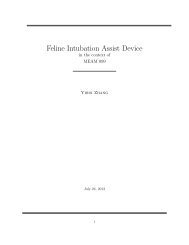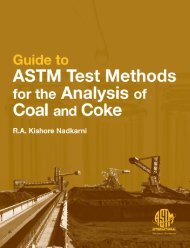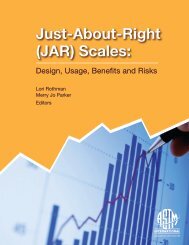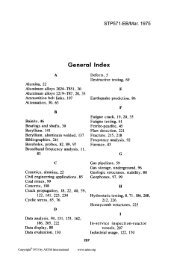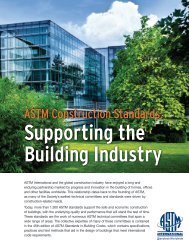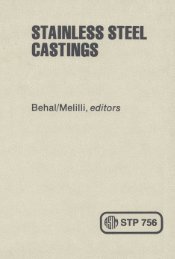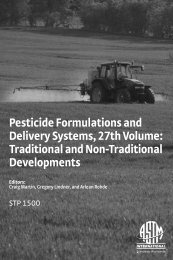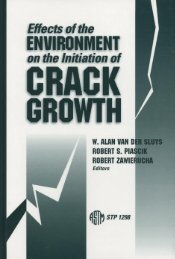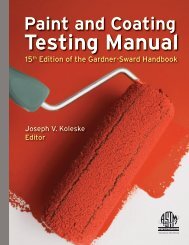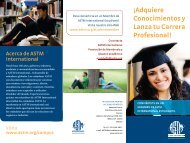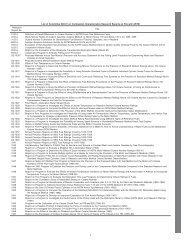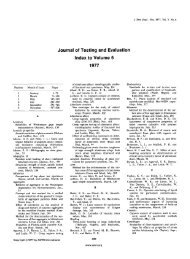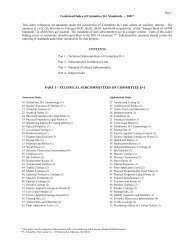Form and Style for ASTM Standards - ASTM International
Form and Style for ASTM Standards - ASTM International
Form and Style for ASTM Standards - ASTM International
Create successful ePaper yourself
Turn your PDF publications into a flip-book with our unique Google optimized e-Paper software.
wording of orders. After the attention of the<br />
purchaser is directed to all of the options in the<br />
specification, his attention might be directed to<br />
what would be furnished by the supplier if the<br />
purchaser fails to specify one or more of the<br />
options.<br />
B9.3 It is recommended that this section be<br />
included in all specifications as a checklist of<br />
items to be included in a purchase order or<br />
contract. If this list contains any <strong>ASTM</strong> designation<br />
(including referenced documents), it is desirable<br />
to specify “year date(s)” to avoid misunderst<strong>and</strong>ings<br />
between contractual parties.<br />
B9.4 When citing a combined st<strong>and</strong>ard,<br />
indicate the system of units to be applied. For<br />
example:<br />
X.X This material/product shall con<strong>for</strong>m to the requirements<br />
stated in SI units of Specification A36/A36M.<br />
B10. Materials <strong>and</strong> Manufacture<br />
B10.1 General requirements regarding the<br />
materials <strong>and</strong> method of manufacture to be used<br />
may be included when deemed helpful to the user<br />
of the st<strong>and</strong>ard, such as the open-hearth, electricfurnace,<br />
or basic-oxygen bessemer processes<br />
generally specified <strong>for</strong> steel products. When the<br />
material, product, or system specified is made<br />
from two or more materials or products, this<br />
section should state briefly the general requirements<br />
of the materials or products to be used <strong>and</strong><br />
the process to be followed in manufacture,<br />
including items such as the nature <strong>and</strong> character<br />
of any alloys, fillers, saturants, antioxidants, coatings,<br />
<strong>and</strong> plasticizers.<br />
B11. Chemical Composition<br />
B11.1 When necessary, detailed requirements<br />
shall be given as to chemical composition<br />
<strong>and</strong> other chemical characteristics <strong>for</strong> the material,<br />
product, or system. Frequently these are<br />
presented in tabular <strong>for</strong>m. It is most important<br />
that the following in<strong>for</strong>mation be clearly indicated:<br />
(1) name of each constituent specified, (2)<br />
whether the requirement is a maximum, minimum,<br />
or range, (3) whether an allowance <strong>for</strong><br />
measurement error is incorporated in these limits,<br />
(4) the units applicable, (5) references to notes or<br />
footnotes when necessary <strong>for</strong> further clarification,<br />
<strong>and</strong> (6) appropriate analytical methodology.<br />
FORM OF <strong>ASTM</strong> SPECIFICATIONS<br />
B-4<br />
B11.2 The sequence of items specified shall<br />
be consistent within a related group of specifications.<br />
B11.3 The preferred introduction <strong>for</strong> this<br />
section is: “The material shall con<strong>for</strong>m to the<br />
requirements prescribed in Table 1.”<br />
B11.4 Limits on Nonspecified Elements— It<br />
is suggested that the following statement be<br />
added to tables of chemical requirements as<br />
applicable to replace the requirements <strong>and</strong> statements<br />
presently being used regarding nonspecified<br />
elements: “By agreement between purchaser<br />
<strong>and</strong> supplier, analysis may be required <strong>and</strong> limits<br />
established <strong>for</strong> elements or compounds not specified<br />
in the table of chemical composition” (see<br />
also Section B24).<br />
B12. Other Requirements<br />
B12.1 When necessary, detailed requirements<br />
should be given as to characteristics to<br />
which the material, product, or system shall<br />
con<strong>for</strong>m. Frequently these are presented in tabular<br />
<strong>for</strong>m. It is most important that the following<br />
in<strong>for</strong>mation be clearly indicated: (1) name of<br />
each property or requirements, (2) whether the<br />
requirement is a maximum, minimum, or range,<br />
(3) whether an allowance <strong>for</strong> measurement error<br />
is incorporated in these limits, (4) the units<br />
applicable, (5) references to notes or footnotes<br />
when necessary <strong>for</strong> further clarification, <strong>and</strong> (6)<br />
appropriate test methodology.<br />
B12.2 Physical Properties— Present the<br />
requirements <strong>for</strong> electrical, thermal, optical, <strong>and</strong><br />
similar properties in this section, usually in tabular<br />
<strong>for</strong>m.<br />
B12.3 Mechanical Properties— Present the<br />
requirements <strong>for</strong> tensile strength, yield strength,<br />
elongation, <strong>and</strong> similar properties in this section.<br />
B12.4 Per<strong>for</strong>mance Requirements— Include<br />
functional, environmental, <strong>and</strong> similar requirements<br />
in this section when necessary.<br />
B12.5 Other Requirements— Include additional<br />
requirements as needed.<br />
B12.6 In preparing a specification it is<br />
essential to make sure that there is a test procedure<br />
<strong>for</strong> determining con<strong>for</strong>mance <strong>for</strong> each<br />
requirement. These shall be listed in the specification<br />
(see Section B18).



